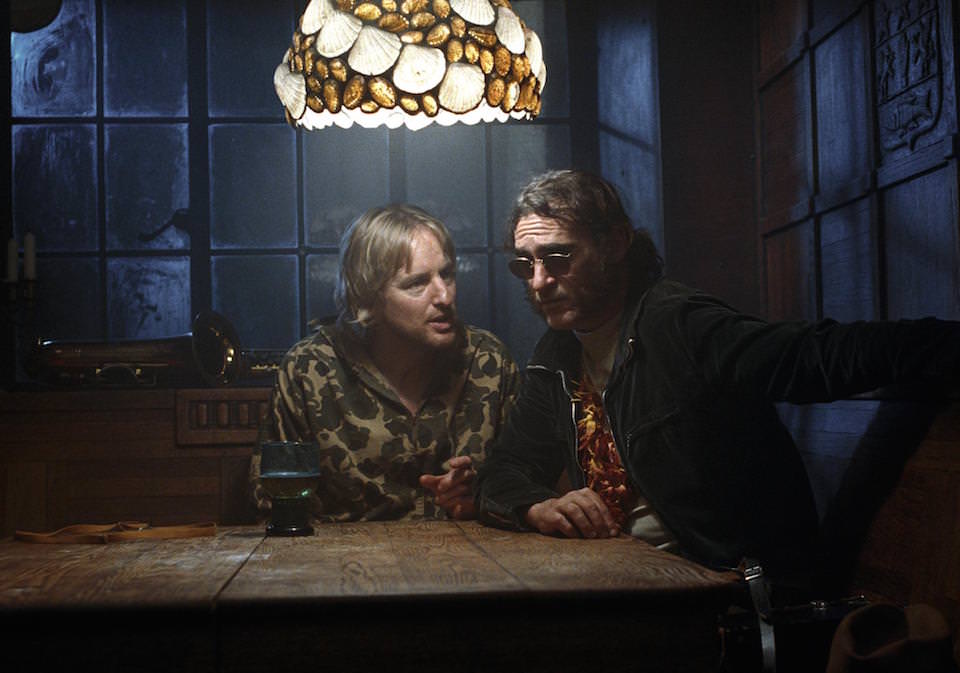Thomas Pynchon’s Inherent Vice (2009)—his extravagantly convoluted version of the private eye novel, set amid the detritus of the end of the 1960s—is the kind of verbal construct that at first glance seems inherently unsuited for filming, certainly not as a widescreen spectacle with an all-star cast. To say that Paul Thomas Anderson has faithfully and successfully adapted it to the screen is another way of saying that he has changed it into something entirely different.
Perhaps the novel really was crying out for such a cinematic transformation, for in its pages people watch movies, remember them, compare events in the “real world” to their plots, re-experience their soundtracks as auditory hallucinations, even work their technical components (the lighting style of cinematographer James Wong Howe, for instance) into aspects of complex conspiratorial schemes. In the latter stretch of the book, Pynchon’s stoner private eye Larry “Doc” Sportello finds himself alone on a Saturday night getting ready to watch the Val Lewton production I Walked with a Zombie on television: “He had seen this zombie picture a couple of hundred times and still got confused by the ending, so he spent the news hour rolling joints to help him through, especially with the calypso singing, but somehow despite his best efforts fell asleep in the middle, as so often before.” It’s an amusing and seemingly dead-end aside—if in this fictional universe of infinite connectivity any end can definitively be classified as dead—the joke being the notion of a character in a Pynchon novel baffled by a narrative twist in an RKO supernatural thriller from 1943.
Naturally enough the complications of the Lewton film—masterpiece though it is of elliptical leaps and oblique suggestion—can hardly compare to the proliferating plot points in Pynchon’s book, his familiar whirlpool of psychic jetsam whose eddies only generate further unresolvable complexities. Here the whirlpool is calibrated to a precise historical moment that long ago became stereotypical, and whose full peculiarity Pynchon seeks to restore: that sudden awareness of the evaporation of the counterculture—articulated in 1970 in John Lennon’s “the dream is over”—and experienced by Doc Sportello, while it is happening, as “a low-level bummer… about how the Psychedelic Sixties, this little parenthesis of light, might close after all, and all be lost, taken back into darkness.”
The private eye form provides Pynchon with a vehicle for investigating the question of who lost, or stole, or killed, or brainwashed, or denatured the Sixties—never mind that no satisfying answer could conceivably be forthcoming. Pynchon seems to have ingested an entire archive of genre variations, ranging from the classic forms of Raymond Chandler and Ross Macdonald to every subspecies of pastiche and burlesque: Roger L. Simon’s pot-smoking detective Moses Wine, Gregory MacDonald’s Fletch, the Coen Brothers’ Dude in The Big Lebowski, a hundred TV spinoffs. It’s not a question of homage but of throwing absolutely everything into the mix for processing, every stray particle of a commonly shared culture—every joke good or bad that you ever heard, every commercial you couldn’t escape from, every sex fantasy or tabloid crime story that inhabited your dreams, every tag line dredged up from ancient comic strips or pulp stories. This is a book that derives a good part of its narrative arc from an investigation into the cryptic message: “Beware the Golden Fang.”
The stoned detective is the perfect surrogate psychopomp, and Doc’s surfside pad in the mythical Gordita Beach the still center from within which to contemplate the swirl of surf bands and massage parlors, Nazi biker gangs and Black revolutionary collectives, FBI agents and tarot-reading mystics, a police detective moonlighting as a real estate shill, a cocaine-addled dentist fronting for an Asian heroin-smuggling ring, a blacklisted movie actor resurfacing as a star of anti-Communist B movies, a rehab clinic whose New Age slogans may mask sinister forms of psychological engineering—and the girl, of course, the indispensable figure of the lost girl, the abducted girl, the co-opted or corrupted girl whose fundamental unreadability might be the alpha and omega of all the mysteries.
In Pynchon’s book it’s all there yet not there; the brilliantly sharp delineations of place (“plastic trikes in the yards, people out watering the flowers and working on their cars, kids in the driveways shooting hoops, the high-frequency squeal of a TV sweep circuit through a screen door”) flare against the dark and fade out. Doc himself is finally nothing but a conduit for language to mate with itself, to engender worlds within imaginary worlds, bubble worlds giggly or unsettling, a flickering consciousness always at the edge of vanishing altogether.
The words in Anderson’s film are mostly Pynchon’s; the plot elements too, however freely they have been culled and transposed; the free-associative multiplicity and ricocheting mood changes are carried over with a miraculous lightness of touch. Yet Inherent Vice the movie is utterly its own thing, as thoroughly a piece of Anderson’s imaginative universe as of Pynchon’s. If Pynchon’s Doc Sportello could stare at a movie and feel puzzled by what he’s seeing, here it’s as if the movie stared back, infusing the materials of the novel with further ambiguities of emotion and association, pervading it with the actual California sunlight that feels like the movie’s binding force. People glide through it or are trapped or exposed by it. It offers promises of innocent happiness or flattens everything with an overlay of blinding impersonal brightness.
Advertisement
From the start—framing its opening exchanges in close-ups as if in the middle of a scene—the film has an intimate, off-kilter tone that manages to coexist with all the extravagant comedy and visual grotesquerie. It is not a question of shifting moods but of the bizarre fusion of seemingly contradictory moods into some not quite identifiable state of mind, a condition quite compatible with the wrenching extremes of attitude and comportment that might be commonly encountered in California in 1970. Anderson was in fact born that year, but he channels its atmosphere—its sense that everything has just been freshly reinvented and is already starting to fall apart—with the same mediumistic certitude he brought to other eras in Boogie Nights and There Will Be Blood and The Master. Inherent Vice takes its place in what is emerging as an inner history of California and by extension of America.
Like those earlier films it is epic in conception, though here the epic mode seems inspired, visually at least, by the outsized comic forms of Frank Tashlin and Jerry Lewis: at certain climactic moments the screamingly primary colors and widescreen expansiveness call to mind Tashlin’s Martin-Lewis swan song Hollywood or Bust (1956). Everything is jarring, glaring, impossible not to look at. Josh Brolin, playing the relentlessly harassing, sad-hearted cop “Bigfoot” Bjornsen, sports a flattop haircut resembling a granite mesa and sucks on a frozen banana with unconscious pornographic relish; Joaquin Phoenix as Doc, the most implausible of private eyes, becomes a walking sight gag as he sports a succession of hilariously outlandish clothes and hairstyles.
Anderson has cited as a source of inspiration the underground comic The Fabulous Furry Freak Brothers by Gilbert Shelton, famous for its motto that “dope will get you through times of no money better than money will get you through times of no dope.” Faithfully reflecting Pynchon’s text, Doc’s on-screen consumption of drugs, from laughing gas to cocaine to the joints he seems to be continuously rolling, becomes a deep sustaining chord, like the endless shots of the cattle herd moving forward in an epic western like Red River. In the Sixties young people habitually got stoned and went to the movies. Inherent Vice, in a reversal of screen and spectator, seems to be getting stoned in place of, or on behalf of, the audience. The visualized marijuana fumes are too insistent to be decoration or comic relief; they’re the very medium through which we see what is going on, an implied shared high by which we participate in Doc’s dream and in the midst of which we too wake up.
Yet if everything is at first sight a dream, a hallucination, a doper’s paranoid exaggeration, we are always looking at faces that say more than even Pynchon’s baroquely elaborating dialogue can. We seem to watch at least two quite different movies at the same time, one exhilaratingly fast and funny, the other unaccountably jagged and sad. The real is always insistently coming through. The story, such as it is, might be conceived on an elementary level as the reverie of a man who has lost his girlfriend and dreams of her return. The dream recoils on itself in the extraordinary episode, fusing lust and emotional pain, when Doc’s lost love Shasta (Katherine Waterston) returns to reveal the flower girl transformed into a rich man’s plaything, cooing fantasies about “Manson chicks,” transforming the hippie Eden of radiant uncoercive ecstasy into an enactment of paid-for submission that Doc cannot resist since it’s an exact playback of his own secret wishes. Such at least might be one reading of this prolonged and constantly shifting scene, comic as written by Pynchon but harsh enough, under Anderson’s direction, to stop the film momentarily in its tracks.
Pynchon’s characters are mental cartoons given fleeting life through language alone. Played by actors as good as those assembled by Anderson, they assert an existence no less grotesque but all the more unavoidably human. Notions become people whose histories are written in their gestures and faces. In the midst of all of this Joaquin Phoenix remains in view. His performance is an uncannily inventive set of variations on a theme. Each close-up is a different face, each hip gesture newly tried out, the constant inventiveness only emphasizing the furious energy required for Doc to remain in the same place. Phoenix’s Doc could be the portrait of a man who resists change with all his force, determined not to be moved from his center, finally finding himself nowhere at all. In a confrontation with the wonderfully named Crocker Fenway, the ultimate embodiment of shadowy WASP authority, Phoenix is sublime as he performs a flawlessly studied display of casually defiant posturing and then switches it off in the face of Fenway’s utter indifference. (Fenway, in the same scene, gets off one of Pynchon’s best lines: “People like you lose all claim to respect the first time they pay anybody rent.”)
Advertisement
In the end Doc is cruising along somewhere in the night, maybe back together for keeps with his love but probably not, his face once again dominating the screen, caught in lights that give it a glacial melancholy look. At this point Anderson closes things out with one of Burt Bacharach’s most beautiful and melancholy songs, the exquisite “Any Day Now,” sung by Chuck Jackson when the Sixties dream was young: “And the blue shadows will fall all over town…” It comes out of nowhere and feels exactly right in its unexpectedness, like so much in Anderson’s remarkable film.




